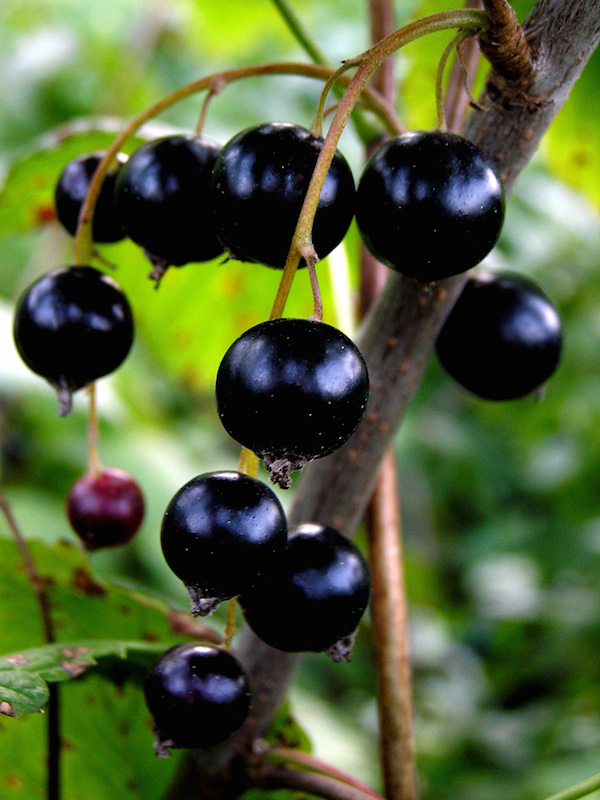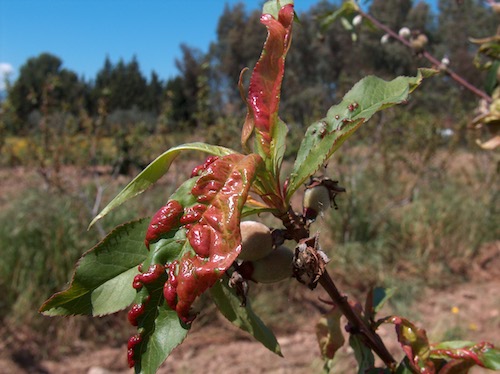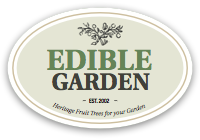Hints and Tips from Edible Garden Fruit Trees
Autumn Hints & Tips
Download our free Autumn hints & tips for the Edible Garden - click here.
Pruning Redcurrants
Red and white currants differ from blackcurrants in that they produce most of their fruit on fruit spurs which appear on older wood. These fruit spurs appear clustered closely at the base of side shoots and therefore when training try to create a goblet shaped bush with 8-12 main branches growing upwards and outwards bearing short fruit spurs. Laterals that develop on the main branches should be shortened in winter to induce fruit spurs. Terminal growth of branches should be tipped.
Pruning Blackcurrants
Once planted the Blackcurrant should be cut down to ground level. This hard pruning at planting time results in strong new growth from the base, fruit is borne on 1 year wood. During the first summer strong young branches should develop, but there will be no suggestion of fruit at this stage. The first winter after fruiting, remove a 1/4 to 1/3 of the wood, cutting right back to ground level. Once established, remove about 1/3 of the bush cutting out weak, damaged or crossed over branches. Cut back old fruiting branches to a strong shoot. Pruning can be carried out after autumn leaf fall and before spring bud burst. Blackcurrants require lots of nitrogen such as fresh poultry and cow manure.

Leaf Curl Fungi (Taphrina deformans)
Leaf curl is a common fungal disease that effects peach, nectarine, peachcott, and peacherine etc trees. It causes the leaves (and sometimes the fruit) of the infected tree to become puckered, curled and much thicker than normal. If left untreated the problem will get worse year-after-year and reduce the tree’s ability to produce lots of fruit.
 Over winter the fungal spores take up residence in different parts of the tree, but mainly in the buds. When the cool wet weather of spring and summer arrives many leaf curl spores are produced and are then splashed or blown from tree to tree. Because this is also the time the trees are breaking bud and forming new leaves, the new growth is easily re-infected with leaf curl.
Over winter the fungal spores take up residence in different parts of the tree, but mainly in the buds. When the cool wet weather of spring and summer arrives many leaf curl spores are produced and are then splashed or blown from tree to tree. Because this is also the time the trees are breaking bud and forming new leaves, the new growth is easily re-infected with leaf curl.
Controlling leaf curl isn’t easy but good orchard hygiene habits, which should be repeated each year, will give you the best chance.
First of all, plant your trees where they will get adequate air movement – this will help minimise fungal problems.
Next, in spring apply a light dressing of a quick acting fertiliser such as sulphate of ammonia to encourage new leaf growth. At the same time, I also recommend applying a seaweed fertiliser, such as Seasol and Comfrey spray, to help the plants’ immunity to leaf curl.
If you do get leaf curl, during spring is when you will notice it in your trees. Once you notice the symptoms of leaf curl in your leaves it is too late to control the disease in those leaves but there is lots you can to do try and stop the fungus from spreading.
The first step is to remove and destroy as many infected leaves as practical. But don’t compost these as it will spread the infection.
In autumn and early winter clean up around the base of any peach, nectarine etc trees and removing as many leaves as possible. Because these types of trees are susceptible to leaf curl, I suggest doing this regardless of whether they’ve shown any signs of disease. And, again remember – don’t compost the leaves.
Next, you should spray your deciduous trees (the trees that lose their leaves every year) with lime sulphur. The lime sulphur acts by burning off the over wintering fungi and pests, including mites. It’s very important you do this for gooseberry bushes because they are prone to catching mites which can eat out the flower buds, meaning your bush ends up with no fruit. Luckily, the lime sulphur will get rid of those mites.
But I don’t recommend applying it to your apricot trees because they can be sensitive to lime, so it’s best just to avoid it.
In late winter/spring apply a copper-based fungicide to all your deciduous fruit trees – not just peach trees. A copper-based fungicide will help stop leaf curl on peach and nectarine trees but it will also treat fungal problems on other fruit trees – like black spot on apple trees.
I also recommend mixing in the copper fungicide with a spreader/sticker, like RainGard, both of which you can get from your local garden centre. RainGard works a bit like soap. Combined with the fungicide, it will make the whole area you spray wet and then when it dries it sticks to the area so you get good coverage that sticks or stays on the tree for a long time.
The copper fungicide (and spreader/sticker) should be applied while the leaf and flower buds are still closed – right before the buds burst. Spray thoroughly as you need to create a surface barrier to protect against the fungus. Then follow this up with another spray 10-14 days later – particularly if you’ve had lots of wet weather. This will ensure the trees get the coverage they need.
Once you have flower buds showing it’s really important not to spray copper, as it’s very toxic to bees when it’s wet – though fine once it’s dried. And it’s also past the point of the copper being effective as the idea of the copper is to add a protectant layer over the buds, before they burst.
And that’s it for the year. Now, you just have to go back to the beginning of the process and repeat all of the steps – except for applying copper fungicide.
Because copper is a heavy metal it can build up in the soil. It’s also very toxic to bees when wet so should only be used when necessary. If in the past year your trees showed no signs of disease just skip the copper step the following year.
But, if they are newly planted trees; or were affected by fungus or disease; or you had a wet winter; or you didn’t spray with lime sulphur, then you should still apply copper fungicide.
